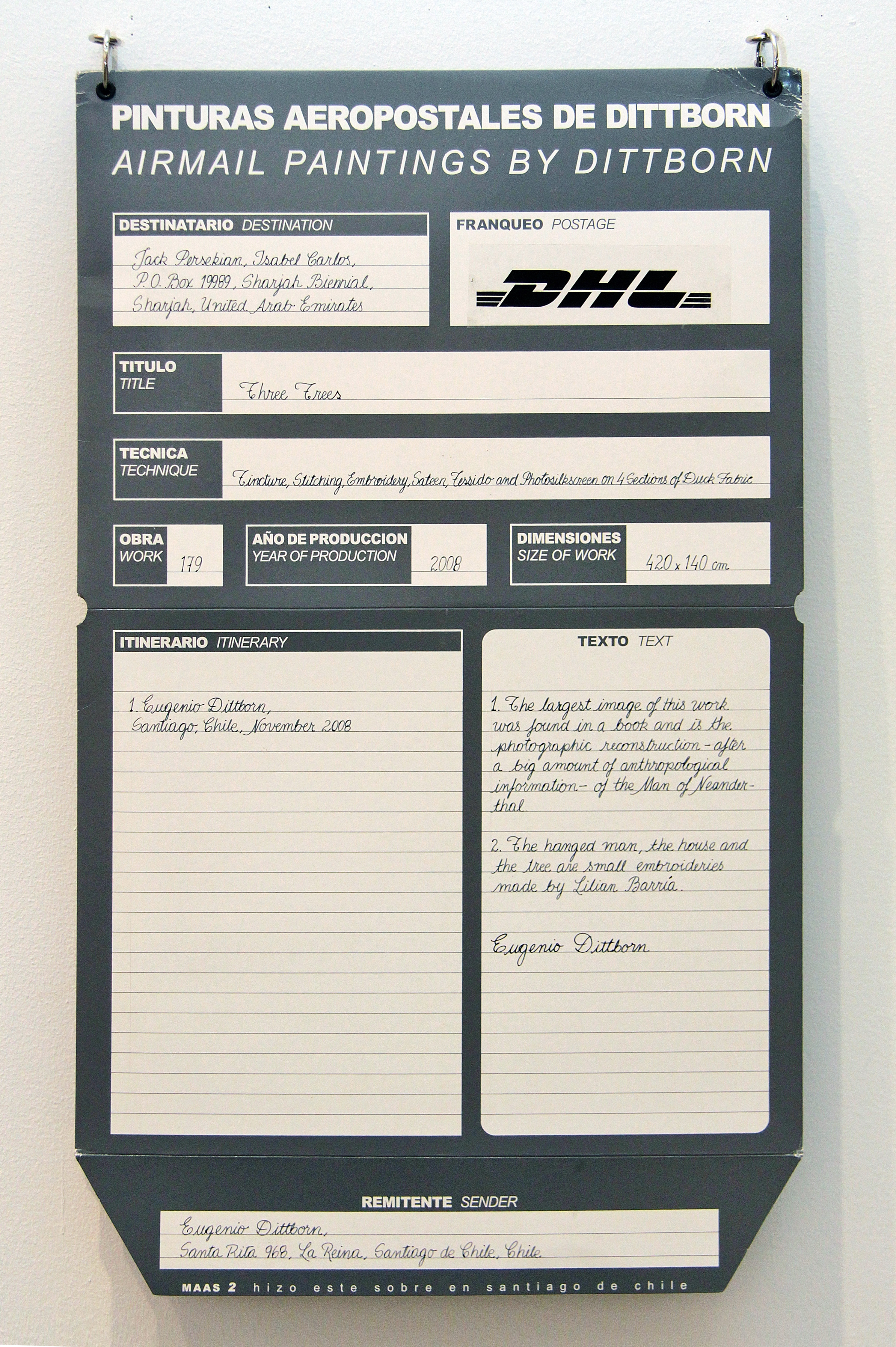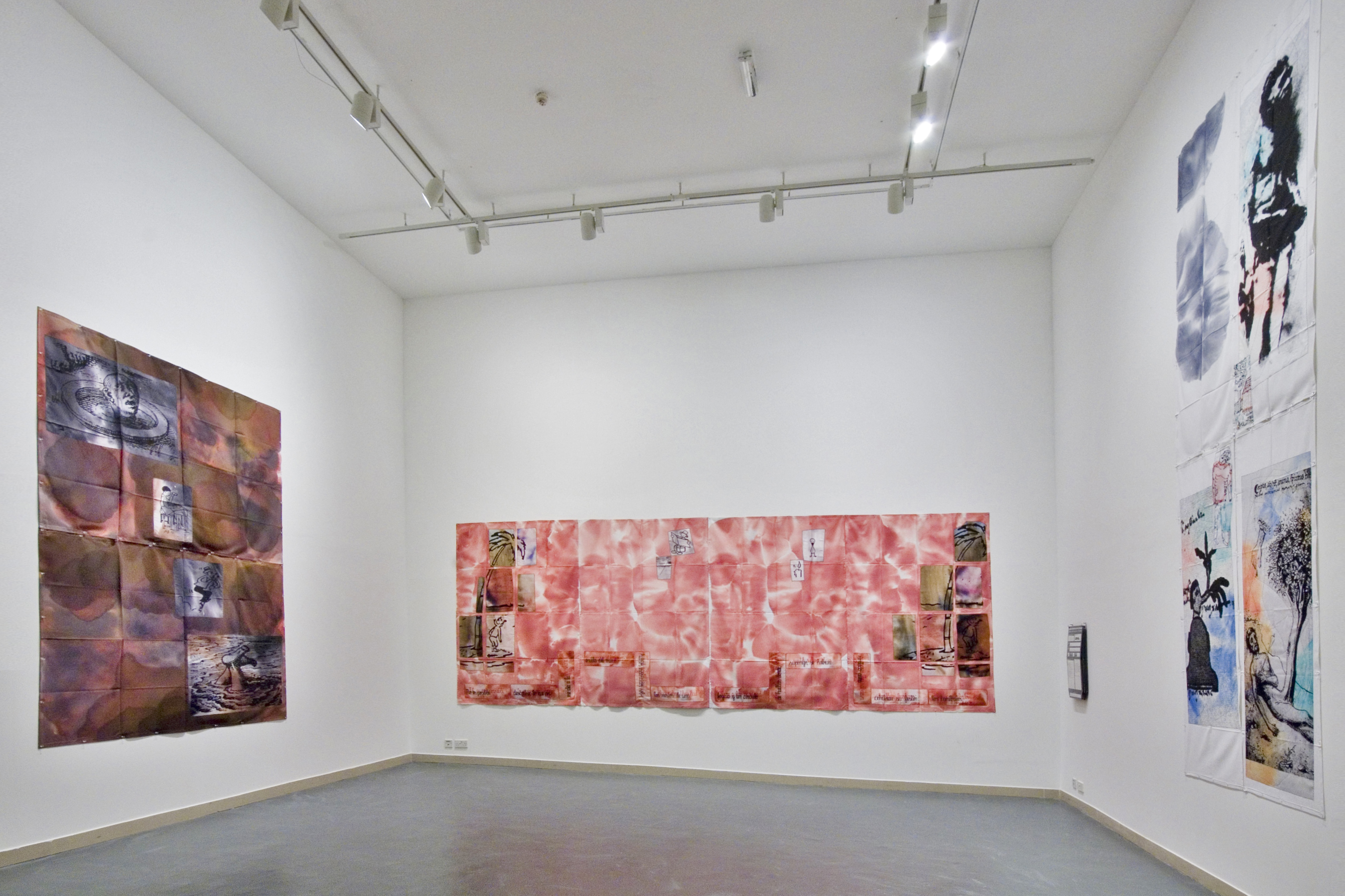
Airmail Paintings, 2002—2008
Eugenio Dittborn
Airmail Paintings, 2002—2008
Paintings
Dimensions variable
Installation view
search


Eugenio Dittborn
Airmail Paintings, 2002—2008
Paintings
Dimensions variable
Installation view
The following is a text in progress, dating back to 1985 and now published in its eighth state; it is the Ars Pictorica of the Airmail Paintings:
1. Dittborn invented Airmail Paintings by accident.
Happening in early 1983 to fold a large piece of wrapping paper four times upon itself, and then unfold it again, he noticed that the wrapping paper was reticulated by its folds. Dittborn’s find was no discovery at all: folding a piece of paper or cloth is the only way to reduce its surface area without tearing it. This knowledge, which men acquired in Neolithic times as they went about their occupations of guarding and burial, provided Dittborn with what he had long been searching for in his work: marks that would traverse his productions while being heterogeneous to them. And then those marks were there: the folds. In late 1983 the first Airmail Painting reached the world.
2. The airmail paintings arrive, and all eyes are drawn to where they hang outspread on the wall. Then they draw away as departure nears. An Airmail Painting is what is seen between two journeys.
3. Folds are the trademark of Airmail Paintings. It is because of them that the paintings change size and fit into envelopes like treasure into chests, children into sleeping bags, loaves into ovens and ashes into urns.
The airmailness of Dittborn’s paintings resides in their folds.
4. Airmail Paintings travel across the international airmail network as folded letters and are exhibited at their destinations as unfolded paintings: they are a double bind. Having bound the sender, they bind the recipient.
Binds for the recipient:
a. Carefully unbind the wrappings;
b. Unfold the fabrics;
c. Assemble them on the wall like Meccano, and
d. Display them as fully assembled paintings.
5. In the post the manoeuver consisted in passing a painting off as a letter. In passing one body off as another.
When this body was unfolded and displayed here or there, then, it showed the marks of its other.
Folds and envelopes were the marks of its other.i Inc., then, produced two bodies that would never meet:
a. Letters in transit, and
b. Homeless paintings
6. One day in 1983, to conquer the world, the Hostage, the Deserter, the Tramp and the Castaway met in Santiago, Chile, and founded Airmail Paintings Inc. The aim of the project was to find a way out for painting. To the world. And so it was: through global networks made up of infinitesimal and boundless segments, all of them impalpable, Airmail Paintings practiced the only radical form of tourism: playing always, and everywhere, away. Here too.
7. Airmail Paintings are secret. They move in the darkness of the night, in the darkness of an aircraft, in the darkness of an envelope. The envelopes were three in number: womb, house, tomb.
8. Is not the History of Painting a cookery book?
The elements involved in the production of an airmail painting are similar to those used to prepare a small banquet: none is self-sufficient, none is alive or dead, none has an age or specific weight, nor is its scope agreed, or the effects of its position upon the whole; none is smooth, harsh, soft or watery; all are ready and available, waiting to be connected and thus relinquish their original inertia and, in falling, produce.
9. They are hieroglyphic abbreviations, these figures found scattered around the page edge, at the sides, borders and margins of other pages. Light, mobile, frail and invulnerable, they recall the drift of those small objects of varying kinds that the ocean throws up on the shore: corks, feathers, papers, sticks, vertebrae, cloths, little bits of rubber and plastic, which after floating for a long time indicate that there are journeys without itineraries and that we too have reached them without a map.
10. Pieces of cloth steeped in dye, then dry and afterwards silk-screened, were cut with scissors and transferred to the support. After a long time pinned there they were tacked into place, whereupon they took up permanent transitory positions: textile grafts that discontinued the surface of the Airmail Paintings.
11. Airmail Paintings have changed publics, skies, routes, envelopes, meridians, parallels, whereabouts, airlines, destinations, recipients, airports, itineraries, hemispheres, trajectories, continents, headings, homes.
And they have changed paint for dye.
12. The dye placed its concentrated weightlessness at the service of mobility, marked the printed figures, crossed folds and tacks and stained, finally, other stains. Saliva and tears soak the cloth that wraps the newly severed head of the king.
2009
Excerpted from Provisions, Book 1, catalogue for the 9th Sharjah Biennial
This project was part of Sharjah Biennial 9
Eugenio Dittborn
2002—2008
Paintings
Dimensions variable
Installation view
Photo by Alfredo Rubio


Published to accompany Sharjah Biennial 9, Provisions is an experimental catalogue approaching the space of the book as an art project.

The second book in the Provisions series looks at the experience of taking part in and attending a biennial.

Since 1983 all of Eugenio Dittborn’s work has been meticulously folded and packed into cardboard airmail envelopes and sent by post to exhibitions around the world.